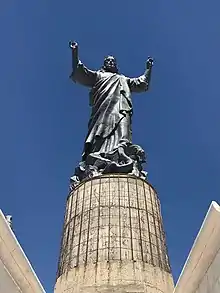Statue of Jesus (Saidnaya)
The Statue of Jesus in Saidnaya, titled I Have Come to Save the World, is the tallest Jesus Christ statue in the Middle East, completed on 14 October 2013, which coincided with a religious holiday for Orthodox Christians who celebrate the feast day of the Protection of the Most Holy Virgin Mary.[1] The figure is 12.3 metres (40ft) tall and stands on a base that brings its height to 32 metres.[2]
 Statue of Jesus in August 2018 | |
| 33.72801°N 36.37282°E | |
| Location | Saidnaya, Syria |
|---|---|
| Designer | Artush Papoian |
| Type | Statue |
| Material | Bronze |
| Height | 32 metres (105 ft) |
| Completion date | 14 October 2013 |
Location
The statue, arms outstretched, has been placed on a historic pilgrim route from Constantinople to Jerusalem, is near the Cherubim Monastery in the community of Saidnaya, about 17 miles north of the city of Damascus, at an altitude of 6,889 feet (2,100 m) above sea level.[3]
The ensemble with the blessing Christ in its center, seen from Lebanon, Jordan, Palestine and Israel, is designed to bring peace, mutual understanding, and hope for common salvation to a region engulfed in the flames of war.
— The Moscow Spiritual Academy, Interfax
Construction
The statue, created by the Armenian sculptor Artush Papoian, was the brainchild of Yury Gavrilov, a 49-year-old man from Moscow who runs an organization called St Paul & St George Foundation in London.[3] The Foundation, which Samir Shakib El-Gabban directs, was previously named the Gavrilov Foundation, after Yury Gavrilov.[4]
After this idea emerged in 2005 it was blessed by Patriarch Ignatius IV of Antioch and the Middle East, who was the author of this idea, Jesus Christ who is offering his blessings is trampling upon a snake, which is the symbol of evil. There is Adam on his right side and Eve on his left side. The Patriarch of Antioch chose the Cherubim Mountain because Cherub, as is known, is a symbol taken from the Old Testament, which is used by the Christians and which is accepted by the believers of Islam.
— Samir Shakib El-Gabban, Voice of Russia
Priests, theologians from the Trinity Lavra of St. Sergius in Russia and Artush Papoian were part of the eight-year project started in 2005. By 2012, the statue which was assembled in Armenia was ready, but Syria was in civil war, causing the project's biggest delay.
Majority Sunni Muslims dominate the revolt, and jihadists make up some of the strongest fighting groups. Other Muslim groups along with the Christian minority have stood largely with Assad's government, or remained neutral, sometimes arming themselves to keep hard-line rebels out of their communities.[4]
Churches have been vandalized and priests abducted by the rebels in Saidnaya and Maaloula. Therefore, the Syrian Army & Hezbollah launched a campaign to retake full control of the Qalamoun Mountains during the Battle of Qalamoun.
After securing the area, the statue was shipped from Armenia to Lebanon, then eventually reached Syria to be installed in October 2013.
References
- "Muscovite Builds Record-Breaking Jesus Statue in Syria". The Moscow Times. 22 October 2013. Retrieved 22 December 2016.
- "Statue of Jesus erected on Syrian hilltop". The Guardian. 2 November 2013. Retrieved 22 December 2016.
- "128-Feet Jesus Statue Erected in War-Torn Syria as 'Middle-East's Symbol of Peace'". The Christian Post. 27 October 2013. Retrieved 22 December 2016.
- "In midst of Syrian war, giant Jesus statue arises". Fox News World. 2 November 2013. Retrieved 22 December 2016.